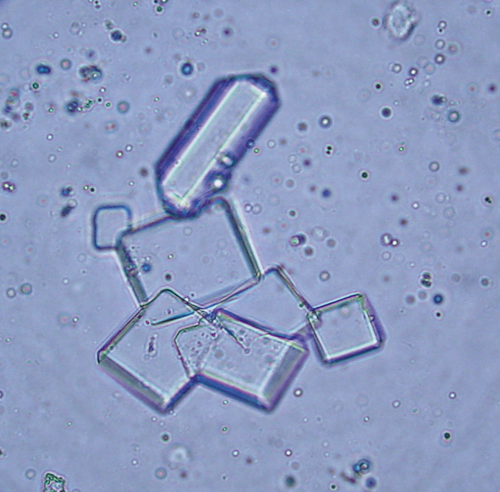Difference between revisions of "Feline Medicine Q&A 21"
Ggaitskell (talk | contribs) |
Ggaitskell (talk | contribs) |
(No difference)
| |
Latest revision as of 11:46, 25 August 2011
| This question was provided by Manson Publishing as part of the OVAL Project. See more Feline Medicine questions |
| Question | Answer | Article | |
| What can be seen in the picture of a urine sediment analysis? | This urine sediment analysis shows the typical appearance of struvite (magnesium ammonium phosphate) crystals. |
Link to Article | |
| What is the significance of this finding and how should it be interpreted? | The finding of struvite crystals in urine sediment analysis is not necessarily abnormal and in many cases may be an in vitro artefact (i.e. the crystals precipitate in the urine after it has been collected due to cooling of the urine). Even when seen in freshly collected, immediately examined urine, this can be a normal finding. It indicates relative supersaturation of the urine with crystalloids, but crystals themselves are not a pathological finding. Epidemiological studies have not found any relationship between the prevalence of crystalluria and cystitis. Although their presence may be regarded as a risk factor for urolith development, in most cats they are of no clinical significance. Cats on dry diets are more likely to have crystalluria than those on ‘wet’ diets. |
Link to Article | |
| What is the potential relationship with bacterial infections, and how common is this in cats? | Bacterial cystitis with urease-producing organisms (staphylococci, Proteus) can predispose to struvite crystalluria and urolith formation by degradation of urea and release of ammonium (one of the struvite constituents) and by increasing the pH (thus decreasing the solubility of struvite crystals). Bacterial urinary tract infections are uncommon in cats, and generally only account for 2–3% of cases of lower urinary tract disease. Compromise to normal defences (catheter placement, perineal urethrostomy) will predispose to bacterial infections, as will a lower USG. |
Link to Article | |
